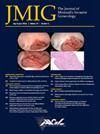外科医生特征对子宫内膜异位症手术结果的影响。
IF 3.3
2区 医学
Q1 OBSTETRICS & GYNECOLOGY
引用次数: 0
摘要
目的:本研究旨在评估外科医生特征与子宫内膜异位症术后手术结果之间的关系,包括并发症发生率、症状复发率、生育结果和再次手术的必要性。设计:人群队列研究。患者:2002年4月1日至2018年3月31日期间,83,787名安大略省患者,生物学上确定为女性,年龄在18-50岁之间,初步诊断为子宫内膜异位症(ICD-9-617或ICD-10-N80)。干预措施:外科医生对子宫内膜异位症病例的数量,分为四类:前一年6例及以下(低量),7 - 11例(中等量),12 - 23例(高量),24例及以上(最高量)。还使用了由外科医生在指数手术前一年的复杂子宫内膜异位症手术量(基于OHIP计费代码)定义的修改暴露变量。测量:主要结果是指数手术后30天内和研究随访期间的再手术率。次要结局是术后并发症、不孕咨询率和子宫内膜异位症手术后的活产率。主要结果:大多数患者(80.3%)接受了小容量外科医生的手术。在术后30天内,容量最大的外科医生的术后并发症发生率最低(5.5%)。与小容积外科医生相比,大容积外科医生的并发症风险显著降低(aHR 0.84, 95% CI 0.74 - 0.96)。较大容量的外科医生倾向于将患者转介进行生育能力评估,这些患者术后实现活产的机会也更高。包括所有检查的手术类型,接受高容量复杂子宫内膜异位症手术的患者接受重复手术的可能性较小(17.8%对32.9%,aHR 0.80(0.72 - 0.88))。结论:我们的研究表明,大多数接受子宫内膜异位症手术的患者都选择了小容量外科医生。术后结果受手术体积的影响,这表明有必要确定手术能力的标准。鼓励正在进行的工作,以确定外科医生的特点和技能,需要进行不同类型的子宫内膜异位症手术。本文章由计算机程序翻译,如有差异,请以英文原文为准。
Impact of Surgeon Characteristics on Endometriosis Surgery Outcomes
Study Objective
This study aimed to evaluate the association between surgeon characteristics and postoperative surgical outcomes, including rates of complications, recurrence of symptoms, fertility outcomes, and need for reoperation for individuals undergoing surgical management of endometriosis.
Design
Population cohort study.
Setting
Ontario, Canada.
Patients
83787 Ontario patients, who are biologically identified as women, aged 18 to 50 who had an initial diagnosis of endometriosis (ICD-9-617 or ICD-10-N80) between April 1, 2002 and March 31, 2018.
Interventions
Surgeon volume of endometriosis cases, grouped into 4 categories: 6 or fewer in the prior year (low volume), 7 to 11 (moderate volume), 12 to 23 (high volume), and 24 or more (highest volume). A modified exposure variable defined by surgeon’s volume of complex endometriosis surgery (based on Ontario Health Insurance Plan billing code) in the year before the index surgery was also used.
Measurements and Main Results
The primary outcome was the rate of reoperation within 30 days of index surgery and over the duration of follow-up in the study. Secondary outcomes were postoperative complications, the rate of infertility consults, and the live birth rate following endometriosis surgery. The majority of patients (80.3%) underwent surgery with a low-volume surgeon. In the 30-day postoperative period, the lowest rate of postoperative complication was noted among the highest-volume surgeons (5.5%). There was a significantly reduced risk of complications among high-volume surgeons compared to low-volume surgeons (aHR 0.84, 95% CI 0.74–0.96). Higher-volume surgeons tended to refer patients for fertility assessment and these patients also had a higher chance of achieving a live birth postoperatively. Patients who underwent surgery with a high volume of complex endometriosis surgeon, were less likely to undergo repeat surgery (17.8% vs 32.9%, aHR 0.80 [0.72–0.88]), including all the surgery types examined.
Conclusion
Our study suggests the majority of patients undergoing surgery for endometriosis have surgery with a low-volume surgeon. Postoperative outcomes were impacted by surgeon volume, suggesting that there is a need to define criteria for surgical competency. Ongoing work to define surgeon characteristics and skills required to perform different types of endometriosis surgery is encouraged.
求助全文
通过发布文献求助,成功后即可免费获取论文全文。
去求助
来源期刊
CiteScore
5.00
自引率
7.30%
发文量
272
审稿时长
37 days
期刊介绍:
The Journal of Minimally Invasive Gynecology, formerly titled The Journal of the American Association of Gynecologic Laparoscopists, is an international clinical forum for the exchange and dissemination of ideas, findings and techniques relevant to gynecologic endoscopy and other minimally invasive procedures. The Journal, which presents research, clinical opinions and case reports from the brightest minds in gynecologic surgery, is an authoritative source informing practicing physicians of the latest, cutting-edge developments occurring in this emerging field.

 求助内容:
求助内容: 应助结果提醒方式:
应助结果提醒方式:


